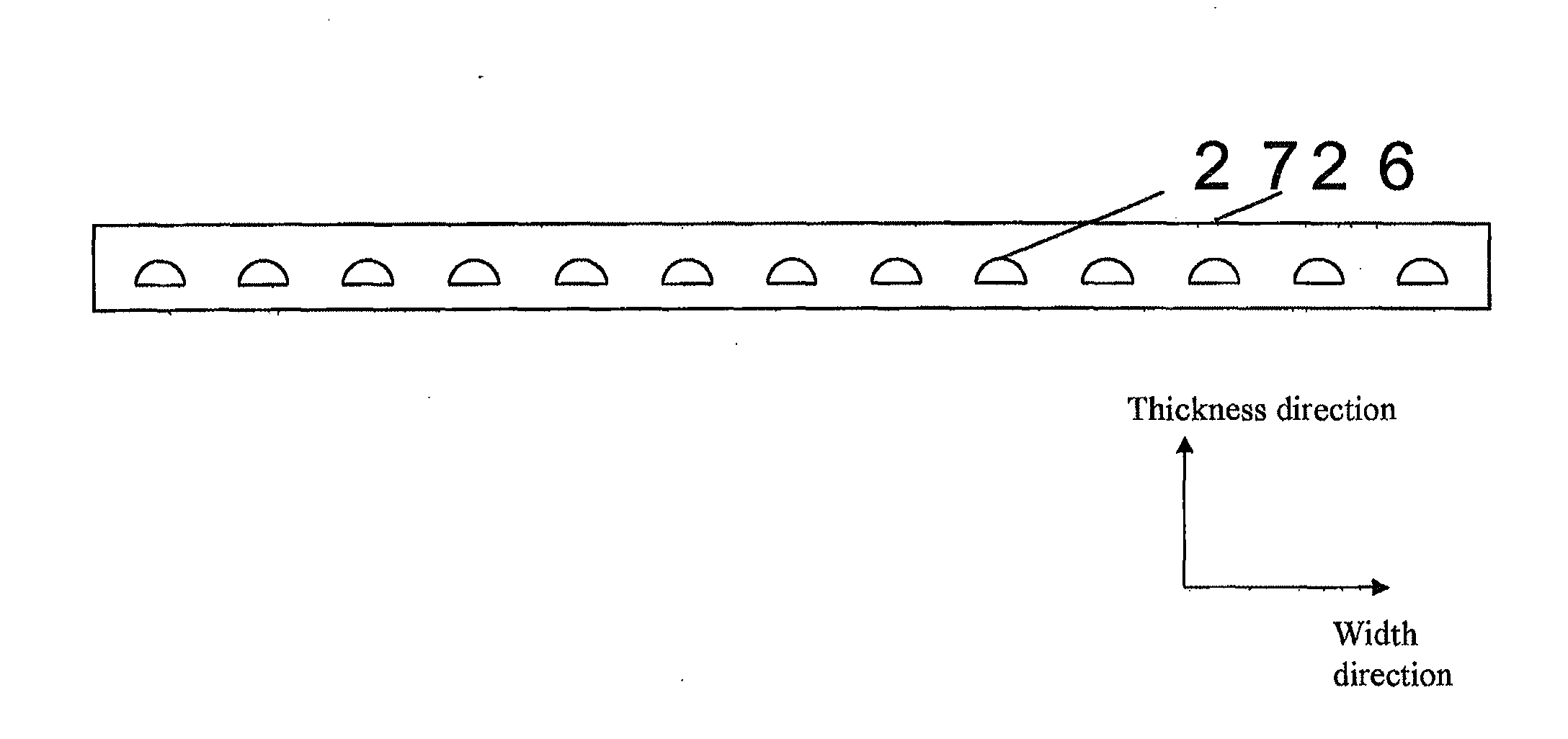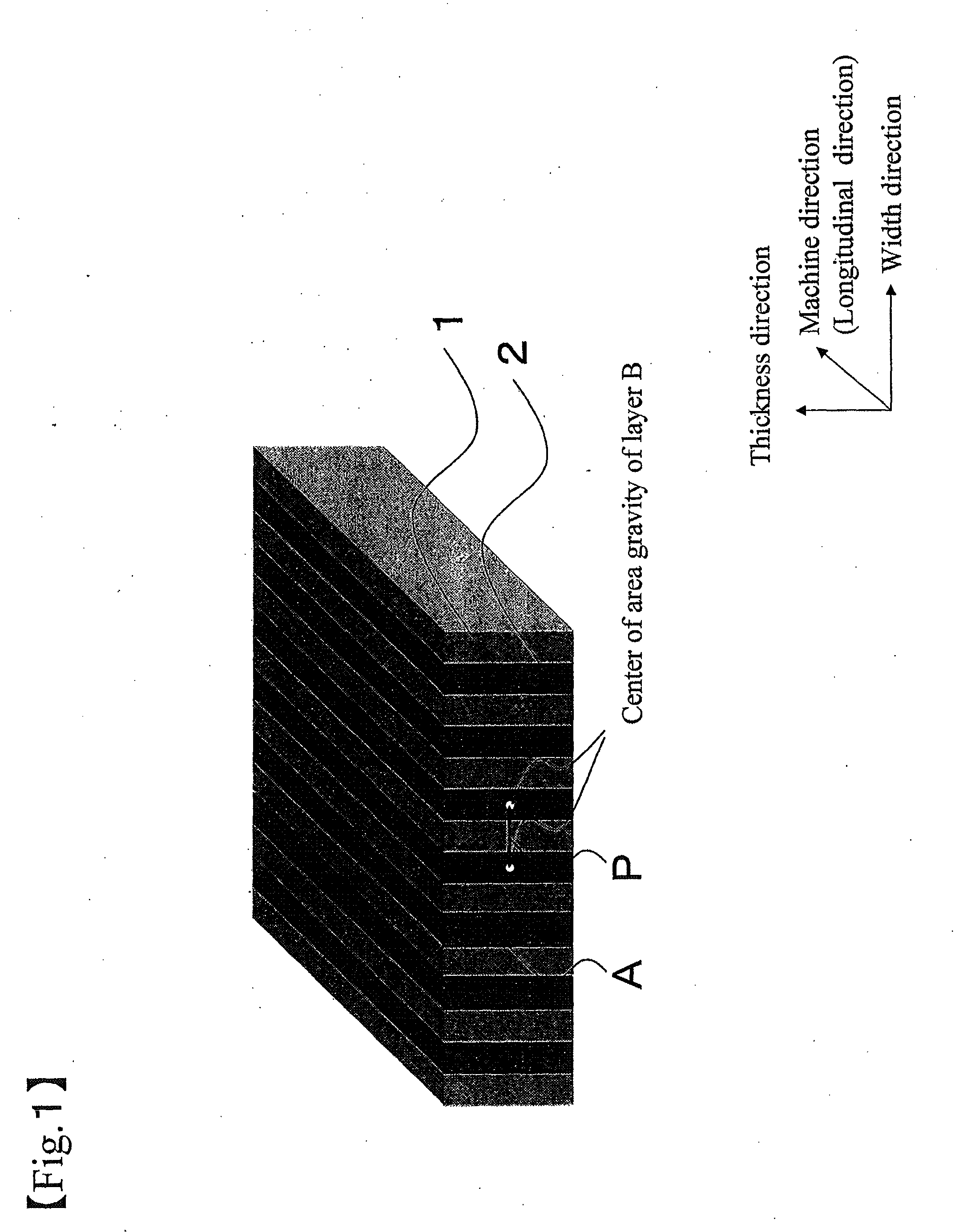Laminated film
a laminated film and film roll technology, applied in the field of laminated film and film roll, can solve the problems of difficult to obtain a large area, inability to obtain a sheet, etc., and achieve the effects of uniform optical properties, low cost, and large area
- Summary
- Abstract
- Description
- Claims
- Application Information
AI Technical Summary
Benefits of technology
Problems solved by technology
Method used
Image
Examples
example 1
[0146]The following resin A and resin B were provided.
[0147]Resin A: Polypropylene (PP)
[0148]Polypropylene Noblen WF836DG manufactured by Sumitomo Chemical
[0149]Resin B: Polycarbonate (PC)
[0150]Polycarbonate LC1700 manufactured by Idemitsu Kosan
[0151]Then resin A was fed to an extruder 1 and resin B was fed to an extruder 2. The resins were melted in the respective extruders at 280° C., and were flown into an extrusion die 700 mm wide as shown in FIGS. 3 to 5 after passing through a gear pump and a filter. The extrusion die was provided with 600 rectangular nozzles, through which the resin B flew. The sheet from the extrusion die was nip-cast on a drum maintained at a temperature of 80° C. while being engaged at the end portions thereof with edge guides. The resultant was then cut off by 45 mm at both end portions and wound with a winder without causing an oscillation. Next, the resultant was wound with a slitter while being subjected to a knurling-process and laminated with a prote...
example 2
[0152]A film was prepared under substantially the same conditions as in Example 1 except that the extrusion die used was 1900 mm wide and provided with 1800 nozzles and that the discharge rate was adjusted. The film obtained had a thickness of 1000 μm (excluding the protective film). Resin B was arranged successively in the longitudinal direction and at substantially regular intervals of 1 mm±0.09 mm in the width direction, forming the structure in which the resin B was covered with resin A. The cross-sectional shape of the resin B was substantially circular and there were 1800 pieces of the resin B with a cross-sectional width of 800 μm±9 μm. Table 1 shows the structure and performance of the laminated film obtained. The film obtained was able to transmit light with a small loss and therefore suitable for an optical waveguide, a light guide and an illumination apparatus.
example 3
[0153]The following resin A and resin B were provided.
[0154]Resin A: Polycarbonate (PC)
[0155]Polycarbonate LC1700 manufactured by Idemitsu Kosan
[0156]Resin B: Polycarbonate (PC)+carbon black (CB) 2 wt %
[0157]Then resin A was fed to an extruder 1 and resin B was fed to an extruder 2. The resins were melted in the respective extruders at 290° C., and were flown into an extrusion die 700 mm wide as shown in FIGS. 3 to 5 after passing through a gear pump and a filter. The extrusion die was provided with 3000 rectangular nozzles that were longer in the thickness direction than in Example 1, through which the resin B flew. The sheet from the extrusion die was nip-cast on a drum maintained at a temperature of 80° C. while being engaged at the end portions thereof with edge guides. The resultant was then cut off by 45 mm at both end portions and wound with a winder without causing an oscillation. Next, the resultant was wound with a slitter while being subjected to a knurling-process and la...
PUM
| Property | Measurement | Unit |
|---|---|---|
| width | aaaaa | aaaaa |
| width | aaaaa | aaaaa |
| width | aaaaa | aaaaa |
Abstract
Description
Claims
Application Information
 Login to View More
Login to View More - R&D
- Intellectual Property
- Life Sciences
- Materials
- Tech Scout
- Unparalleled Data Quality
- Higher Quality Content
- 60% Fewer Hallucinations
Browse by: Latest US Patents, China's latest patents, Technical Efficacy Thesaurus, Application Domain, Technology Topic, Popular Technical Reports.
© 2025 PatSnap. All rights reserved.Legal|Privacy policy|Modern Slavery Act Transparency Statement|Sitemap|About US| Contact US: help@patsnap.com



